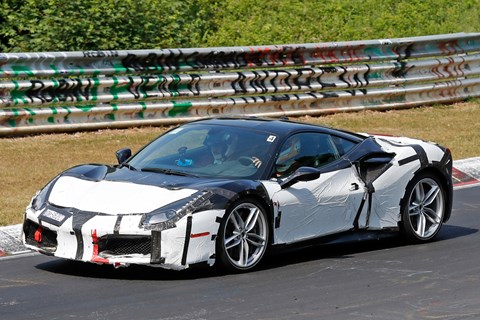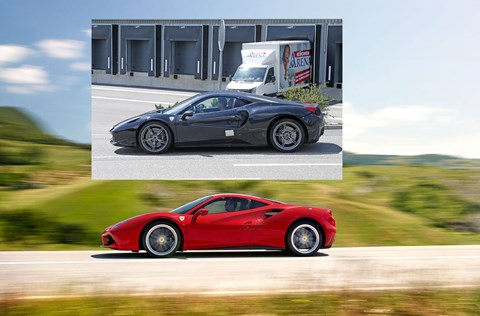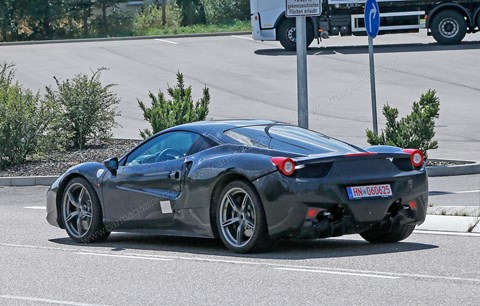► CAR’s artist’s impression of Ferrari Dino
► Plus spyshots of V6 prototype
► 2.9-litre V6, potential PHEV hybrid variant
Few sports cars have been the subject of as much conjecture as the long-rumoured return of the Ferrari Dino.
Latest news is, it’s back on, and even has a development code (F17X) – but the timing is currently thought to stand at 2023. But you never know – legislation, marketing and good intentions may yet bring the programme forward by one year or two.
A new-generation Dino – on again, off again…
Ferrari CEO Sergio Marchionne himself once called it a natural addition to the range, and former R&D chief Amedeo Felisa was reportedly a big fan of the project.
The new sports car will be based on Ferrari’s new, flexible architecture destined for most of its range; the platform will be crafted largely from aluminium to trim weight; and, in the case of the Dino, it will be powered by a new 2.9-litre V6 available in two power outputs, one of which may be a plug-in hybrid range-topper.
The rumoured performance figures are prodigious. On its own, the 2.9-litre twin-turbocharged V6 is good for 610bhp and 443lb ft, sources say.
Meanwhile, the PHEV powertrain is thought to be able to deliver as much as 723bhp and nearly 800lb ft of torque! The electric motor is thought to be packaged between the engine and gearbox, but it may be possible to add an additional electric front-wheel-drive module at a later stage.
It is unclear at this stage if the new junior Ferrari would revive the Dino name, which refers to the son of company founder Enzo. The badge 486 has been mooted.
It’s understood the Dino (let’s call it that for now) sits on a slightly shorter wheelbase than the current 488 GTB, which needs a bit more room for its V8 engine.
How much will the new Ferrari Dino cost?
We are led to believe that the launch of the Dino and the 488’s successor will be accompanied by a substantial price increase – to around 250,000 euro for the Dino and close to 300,000 Euro for the V8 model.
CAR’s artist’s impression
Our artist’s impression, originally published in the September 2015 issue of CAR magazine, shows how the mid-engined, two-seater Dino could look and is based on detailed insider information. There’s a hint of the original 1965 Dino show car’s low-set headlight treatment, and more than a few shades of 2013’s Ferrari 458-based Pininfarina Sergio concept.
Ferrari CEO Sergio Marchionne has previously confirmed the Dino project is active. He told the Daily Telegraph: ‘It’s a when not an if. We know that it [Dino] is an underused resource, but that’s why we need to get it right.’
Could this be a Dino mule on test?

The image above and further pictures in the gallery at the top of the page, of a modified Ferrari 488 GTB photographed at the Nurburgring in June 2017 have onlookers confused. They could be a high-performance 488 variant, a KERS development car, or a Dino mule.
Feel free to join in the debate in the comments section below and let us know what you think.
Ferrari Dino: the first spy photos
The above information follows our earlier spyshots of an engineering mule on test near a supplier base in Germany. Tellingly, it passed by a few minutes before a regular 488 GTB – and the two sounded very different. You’d have to be an acoustically trained Ferrari engineer to tell definitively, but our man with the long lens was confident this prototype wasn’t a V8.

Note also the shortened 488 architecture (Dino prototype inset top, 488 GTB main image). The front structure appears identical to the production car’s, but the rear deck is noticeably shorter (compare the length from the front door to the rear axle), consistent with a smaller powertrain being accommodated; we understand the Dino will be some 120mm shorter than its V8 big brother, despite sharing the same architecture. Don’t forget the car scooped here is an engineering mule – the finished car will look more like the yellow car in our artist’s impression.
Why Ferrari’s downsizing
Maranello faces the same CO2 pressures as the rest of the world: reducing cubic capacity and relying on turbochargers is the easiest solution to make its cars cleaner and less thirsty, while maintaining the shrieking power outputs for which cars bearing the prancing horse are famed. CAR magazine understands the V6 under evaluation in Modena is around 2.9 litres in capacity, handily dodging just under the 3000cc threshold which triggers higher tax rates in markets such as China. It’s similar thinking to Audi dropping the entry-level V8 for its R8 supercar; we revealed in summer 2015 that Ingolstadt is planning a sub-3.0 V6 for its new sports car.
Ferrari V6s: what we know
The new V6 would power a generation of future Ferraris. Think entry-level versions of the next California, due in 2017, and sports cars too. It’s unlikely that Maranello would dilute its biggest-selling sports car – the 488 GTB and Spider – with a V6, but this engine is a dead cert for the Dino.
It’s related to the Alfa Romeo V6 in the new Giulia, but would be heavily revised for use in the Ferrari. This will be the brand’s fourth six-pot effort, following in the wake of Lampredi’s straight six, Jano’s first-generation V6 and Rocchi’s 2.0- and 2.4-litre V6 units in the earlier Dino.
